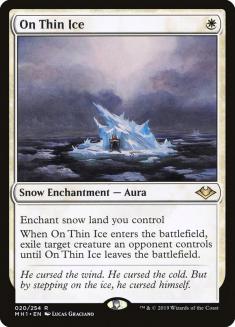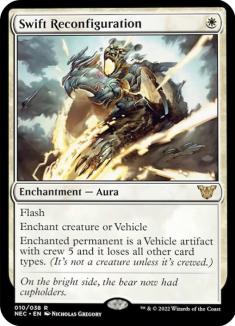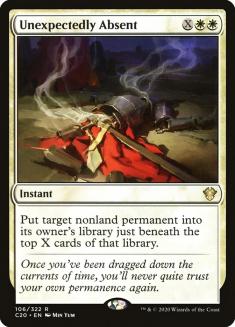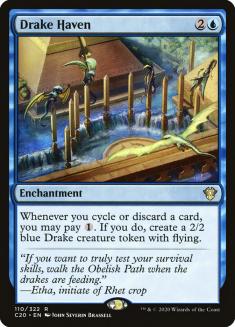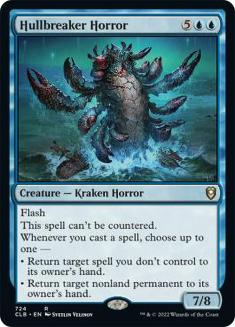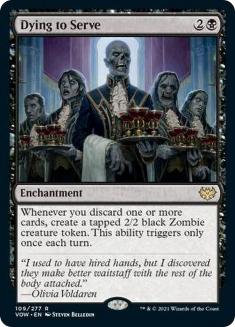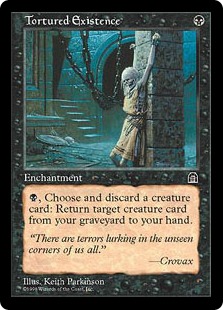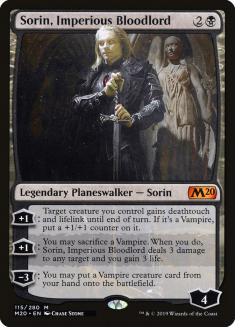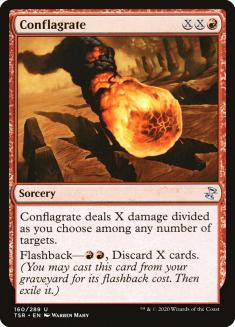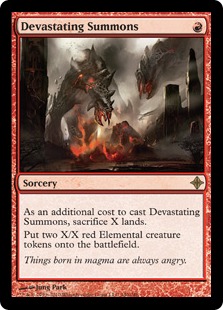Hello, gamers. I’m writing to you from my home office, awaiting what will hopefully be the last winter storm of the season. I’m privileged to observe the spectacle from inside, but there’s allegedly enough snow coming to keep me here for a couple of days. This makes meeting up for a Cube Draft logistically impossible, but it does open up time for one of my other hobbies, thinking about Cube.
As I work on my various Cube projects, I invariably amass small piles of cards on my desk that are coming or going from or to one project or another. Eventually I grow tired of the mess and sort things into the one five-row box I’ve allotted myself for my collection beyond cards that I’m currently playing. A little while back, I was putting away one such pile and found myself reflecting on a handful of cards in my collection that I tried and failed to make work in Cube, and inquired with the people of Twitter whether this is something that y’all would like to read about. People seemed to like the idea, so here we are.
I pulled twenty cards that live in my closet so that I can share what I’ve learned about my attempts to Cube with them. These cards didn’t work out for me in the specific ways that I tried them, though some may be favorites of yours. My goal is not to say “never Cube with these cards,” but merely to reflect on the lessons I’ve learned from them. Additionally, I’ll offer ideas for things that I haven’t tried with these cards, because there’s always a way to make whatever you like work; it just might not be in the framework that you initially desired.
These cards are simply sorted by color and alphabetically, with no weight given to them beyond that for the purpose of this article. Without further ado, I present to you twenty lessons in twenty cards, Part 1.
On Thin Ice
I’ve actually given quite a lot of attention to snow in Cube over the last couple of years, but my experience over this time has reinforced that the odd snow card in my Cubes detracts from the experience. It might not seem like anything radical to just supply snow-covered basic lands to players, but it does add some extra lines to the elevator pitch for your Cube. If you’re playing with the same group all the time or if your Cube has a particular aesthetic that benefits from snow, this isn’t a big deal at all, but when it comes to making a change like this for one or two cards, it’s just kind of funky.
When my Grixis Cube ran on Magic Online (MTGO), I featured an Eldrazi package with some casting costs featuring the colorless symbol and asked if it would be possible to allow players to add any number of Wastes to their deck after the draft. I was told this would not be possible, with my understanding being that this is actually a significant change in the program’s functionality. I was a little miffed at the time, but I’ve come to understand that keeping things uniform as much as possible from one Cube and one draft to another makes the experience much more approachable. Again, house rules can add a lot of fun and customization to the experience, but I personally really value making my Cubes as easy to pick up and play for those with any experience drafting Magic as possible.
Designing a Cube that features snow heavily as a theme is on my Cube bucket list, and when I get to that project, I’ll make the call regarding whether to have players draft all of their snow lands or just to offer snow basics. I think drafting basic lands is profoundly unexciting, so I’ll probably just let players play as many as they want, which is something that players would probably ask about or at least wonder about if you told them they were drafting a Snow Cube. To me, this is the difference between worldbuilding and suspension of disbelief in the world of Cube Draft.
Swift Reconfiguration
Swift Reconfiguration has some things in common with On Thin Ice. The long and short of it is that the card has too much baggage for a simple removal spell. It invites questions more than it relays information about the Cube. When you see a Deceiver Exarch in a pack, you can be very confident that Splinter Twin is somewhere in the Cube. Swift Reconfiguration might cause you to expect the Devoted Druid combo, but this territory is simply less familiar and less of a guarantee.
I’ve featured this combo in a couple of Cubes, and in my experience, things never really line up correctly. It’s also kind of a big ask to draft a Selesnya deck, have the combo, and have something meaningful to do with your infinite green mana. Swift Reconfiguration and Devoted Druid are both pretty playable on their own, which is nice, but again, engaging with Swift Reconfiguration as a player adds layers of complexity that a card like Fateful Absence simply doesn’t.
Where I do like this combo is in environments that have some overlapping combo elements for Selesnya decks. Namely, if a Cube features Vizier of Remedies and all the bells and whistles for Persist Combo, then I’m all about Swift Reconfiguration and Devoted Druid. I see these cards as a great fit for Ryan Saxe’s Classic Cube. I also like it as an option for Cubes with an Enchantress theme, though even there I’d have the expectation of the Devoted Druid pairing.
Essentially, Swift Reconfiguration just ended up being a more specific card than what I would have liked or could easily fit into any environment. There’s nothing wrong with being specific when your Cube supports that specificity, but it’s really deflating when very specific elements just don’t gel with the environment at large.
Unexpectedly Absent
First, I want to say that Unexpectedly Absent is one of my favorite white cards for Vintage Cube. This leads me directly into why I really don’t like the card for any but the highest-power Cube environments.
As a baseline, the most frustrating games of Magic come from the top of your deck not being live. The draw step is the most consistent source of excitement in the game, and not really being able to make use of the top of your deck is what we feel when we’re frustrated by mana screw. As such, the ability to control your opponent’s draw step has the potential to severely diminish their fun. Some of this can be acceptable for the right cost, given the possibility that your opponent might just want to draw whatever you put back, but the more powerful and flexible a card that can disable the opponent’s draw step, the less fun that card is to play against.
Unexpectedly Absent offers way too much for a card in this camp. As the caster, you can target too many kinds of permanents, and the fact that you can put the card further down in the opponent’s deck if it’s good or force them to redraw it immediately if it’s something weak like a Llanowar Elves just offers too much agency for a card that has the potential to be so brutally unfun. It’s important to have tools like this if players are cheating in Griselbrands, but if we’re all just making land drops and casting spells on curve, then this one can really sour a game.
There’s also a matter of taste here when it comes to cards printed in Commander products that were never legal in Standard or even Modern. I enjoy when highly synergistic cards are released in this way and always comb the file for new Cube goodies, but cards printed in this way also invite some of that feeling of suspension of disbelief. True-Name Nemesis was the card that I remember players complaining the most about in Grixis Cube, and at least some of that certainly has to do with a question of legitimacy.
This is not to say that cards that did get a Standard printing just get a free pass. You have every right to complain when you play against Oko, Thief of Crowns or Umezawa’s Jitte in an otherwise balanced Cube! The difference in experience there is that it’s really easy to make the case that these cards are unreasonable. Cards coming in from supplemental products that never got their day under the Constructed sun have the potential for negative outcomes where it’s less certain how reasonable the play patters of the card in question are. This makes me inclined to rule against these cards when I find the play patterns questionable.
Drake Haven
Before I get into this one, I should start by saying that I adore Drake Haven. I drafted it a lot when it lived in my Spooky Cube, but unfortunately, over time, I become all too aware of the card’s warping effect on the environment. Drake Haven generally oscillates between two extremes. As a baseline, churning out one-mana 2/2 fliers is busted, so the question is how many cards can you discard while you control Drake Haven and how efficiently can you do it. If you can discard cards efficiently and often, then you need a good reason to do anything. If you can’t, why are you casting Drake Haven in the first place?
There’s some room for this sort of thing in Cube, especially when it comes to game-ending cards that your group really enjoys. You don’t have to change many words in my last paragraph to mock up a breakdown of the card Opposition, which I strongly dislike for Cube but know to be a crowd pleaser in certain circles. Where Drake Haven really lost me is how this assessment translated into deckbuilding.
Madness is and was a heavily supported theme in my Spooky Cube, and as such the Cube contains a high volume of enablers and payoffs. What I found over time was that Drake Haven simply invalidated too many of the other payoffs. Flameblade Adept is an awesome card that I’m love having a home for, but so long as it existed alongside Drake Haven, it lived exclusively in sideboards. Why would you ever play a one-mana 1/2 when you had access to an enchantment that churns out one-mana 2/2 fliers?
My preference in Cube design is for macro-archetypes that run deep and allow players to explore what cards they want to play and how to combine them. An important aspect of managing these environments is steering away from flagship cards that invalidate other options on power level, and Drake Haven proved to be such a card in an environment meant to allow for aggressive Madness decks. In a Cube where Madness is intended strictly as a controlling archetype, Drake Haven could be a delight, but sadly my copy doesn’t get to come out and play anymore.
Hullbreaker Horror
Hullbreaker Horror is a card that I do not adore, but one that stood out to me as an option for a castable Reanimator target, which is relevant space in the world of high-powered Cubes. The card has failed spectacularly for me as a Reanimator target, and excels a little too much in lower-powered Cubes as a castable threat.
Reanimator decks just require you to jump through a lot of hoops, so you don’t really want a card that asks more of you at the end of the chain. Hullbreaker Horror doesn’t ask for much, but if we’re talking about Reanimation, then we’re often going to be talking about Archon of Cruelty, who asks nothing of you. If we’re talking about lower-power environments, then we’re entering the territory of just casting Hullbreaker Horror being a miserable play experience for the opponent. Typically, the game ends immediately, the Horror dies, or the Horror player wins the game in a drawn out and tedious way if the opponent didn’t correctly concede immediately. This is a pretty poor range of options.
The range of games that Hullbreaker Horror positively impacts is just too narrow to endorse the card for near any environment other than a large Vintage or Legacy Cube. The card’s power level puts it in a no-man’s-land where it’s too much of a backbreaker for more midrange Cubes and not enough of a hammer for environments featuring powerful combos. Really, the only thing that I like about Hullbreaker Horror is the ability to make infinite mana with two Moxen, and hoo boy am I reaching deep to try to give this card praise.
The space that Hullbreaker Horror occupies, that space between high and lower power, is a space that we see expanding all the time with current card design and just how many new cards we’re getting. In theory, there is a high-ish-power Cube that really benefits from Hullbreaker Horror existing as an uncounterable threat, but I will at least say that I haven’t played this Cube.
Dying to Serve
I was initially very excited about Dying to Serve as a card that could exist in the space left by Drake Haven, but I was quickly very disappointed by the way that the card played. For all the text and upside we see on Hullbreaker Horror, we’re also getting cards like Dying to Serve that are long on downsides of creatures entering the battlefield tapped and only entering once a turn.
The story with Dying to Serve is that payoffs need to actually pay you off. Getting two 2/2 Zombies for three mana is a pretty good deal, and more has the potential to be great, but how good is any of this if you can’t net a Zombie right away to impact the battlefield and they all enter tapped? It turns out these restrictions are simply too much for the card to meaningfully play in a moderately high-powered and synergistic Cube. Having the card trigger multiple times a turn is probably too much to ask without a mana requirement, but even having the tokens enter untapped would push this one into the playable zone, I think. As is, the card is similar to Drake Haven, but a little too fixed.
In a world where we have access to so many powerful creatures and threats, it takes a lot for a card like Dying to Serve to be competitive. There’s just too much risk of being run over that comes with casting a card like this. I will say that a Cube that aims for a power level closer to retail Limited does make cards like this much more exciting. I like the idea of casting Dying to Serve and then immediately activating Merfolk Looter, but this is a really easy sequence to outclass if the power level of the environment isn’t on the low side.
Tortured Existence
Tortured Existence is something of a classic, and is an exciting card from a deckbuilding perspective. It has seen some play in Pauper Constructed, and you’ll see it in some Pauper Cubes. For my money and from a gameplay perspective, the card is severely lacking.
The issues that I have with the card in some ways parallel Drake Haven, and in other ways and less directly parallel Unexpectedly Absent. Once you control Tortured Existence, your plays become rather scripted. Ideally you have access to some creature that is strong against your opponent that you can keep recurring, and if that creature is well-positioned, you’ll win eventually. If you don’t have that, then the card doesn’t necessarily do anything.
It’s not a fair assessment to say that a card is good or bad based on whether it wins the game on its own, but a card like Tortured Existence that gives you the option to just commit the same game actions over and over invites that question far more than one-time effects and cards that actually have varied play patterns. If you have something to recur with Tortured Existence that your opponent struggles against, then their draw steps feel pretty blank, and if you don’t, it will often feel like you’ve mulliganed.
Of course, Tortured Existence doesn’t loop cards as effectively in Cube as it does in Constructed, where you have more control over your creature options and access to Grave Scrabbler, but this just increases the games where the card feels more like a mulligan. I don’t personally consider this a selling point. I’d like to see more games in the middle from the cards that I Cube with, and that’s just not something that Tortured Existence reliably offers.
There’s definitely space for a card like Tortured Existence to occupy in a Cube where you want to incentivize players to build engines and loop cards. My experience with the card has been limited to Pauper Cube, where it differs too much from other strategies available to meaningfully generate satisfying games.
Sorin, Imperious Bloodlord
The story behind this one is kind of funny. Immediately, you can identify that Sorin is a very parasitic card that only works if you have a high volume of Vampires in your deck. Sorin is actually likely to be the most powerful card in a Vampire deck, and it’s the juxtaposition of Sorin’s power level and parasitic nature that led to a repeated hilarious occurrence in one of my Cubes.
I tried Sorin with a Vampire theme tied heavily to Mono-Black Devotion, and what kept happening was that somebody would be drafting that deck, open Sorin in Pack 3, draft something else, and plan to wheel the Sorin. The support for Vampires was long enough that the card could catch someone else’s eye even as late as Pack 3, but what really drew this interest of other players is the fact that Sorin is just a busted three-mana planeswalker.
Whether you’re hoping that the four or five Vampires you’ve already drafted can combine with a Champion of Dusk that could show up in Pack 3 or you’re just hate-drafting, there’s plenty of reason not to allow a Sorin to wheel. So in practice, I kept seeing players pass what would definitely be the most powerful card in their deck only to not wheel it, and what’s worse, to have the player who did draft it not even play the card.
Were I to Cube with Sorin again, I would plan to seed Vampires with even more overlapping archetypes. I’d go so far as to have a sacrifice archetype that relied heavily on Bloodghast and similar things so that more than one player would not just be willing to hedge on Sorin, but be very likely to play the card. The ideal situation for cards that would be the most powerful card in your deck is that you’re afraid to pass them not just because you won’t be able to play them, but because somebody else will. Trying to wheel a narrow card, only to have it hate-drafted, is a very unpleasant experience that you can’t totally eliminate in design, but Sorin showed me a circumstance where there were absolutely things I could be doing better as a designer on this front.
Conflagrate
I was skeptical about Conflagrate when I tried it as a Madness enabler/payoff, and my experience with the card in Spooky Cube proved me right. Conflagrate actually has two pretty serious flaws, with multiple flaws being something of a theme for this article…
The first is that Conflagrate comes with Constructed baggage. It’s one thing for a card to see some Constructed success and to be familiar, but this is detrimental when what makes the card good in Constructed doesn’t translate well to singleton environments. A flashed-back Conflagrate is the beginning of the end, or just the outright end of a game in Modern Dredge’s favor. A singleton Cube just can’t guarantee that kind of thing, and you’re more likely to want to actually keep some of the cards in your hand or play them before you can flash the Conflagrate back, and all of these factors lead to the impact of discarding your hand being much smaller in Cube than Constructed.
The second issue is that Conflagrate by design should be a game-ending thing. It’s not that big of a deal for a card to be weaker in singleton than Constructed, but where it becomes a problem is that Conflagrate is pretty weak as anything other than a haymaker. There just isn’t much meaningful play to the card.
So first you have the potential issue of player expectations coming from Conflagrate being a Constructed all-star, which it fails to meet in Cube, and then you add that the card is just not effective as a game piece for the early- or mid-game. The words “Dredge Twobert” popped into my head the other day when I was setting up to write this article, and part of me wants to believe there can be a Cube home for Conflagrate, but if there is, I have not yet seen it.
Devastating Summons
When I first built the Grixis Cube, I wanted to really push the power level of the Cube without actually including power, and one of the interesting puzzles in doing so was in keeping Mono-Red Aggro competitive. One way that I attempted to do this was in giving the aggressive archetype access to some game ending combos – namely, Devastating Summons plus Reckless Bushwhacker.
This idea did come together now and again and was sweet, but over time I realized that it had some of the same issues that I outlined with Conflagrate. You can really only cast Devastating Summons with the intention of ending the game because the cost is so steep. This is a bad fit for aggressive decks, which rely on applying pressure early and often, plus access to some disruption so that the opponent can’t just sweep the rug from under them. Trying to get an aggressive deck to play a combo where at least one of the cards just isn’t good on its own leads to at least as many confused and weak draws as it does combo finishes. Leave the combos to the archetypes that can manipulate their draws.
The worst aspect of Devastating Summons, though, is that sometimes casting it without the ability to give the tokens haste was the right play. This was kind of fine if it came up in a deck that had the combo, but this was a really unfun disaster scenario if it’s just the last playable you had to include to round out your aggro deck.
The cost of sacrificing most or all of your lands is untenable if there’s a possibility that the game might continue for multiple turns. There were somewhat interesting questions regarding how many lands to sacrifice, but no matter what the answer, it was always horrible to sacrifice any and then topdeck a four-drop. In that way, Devastating Summons had problems that overlapped with Unexpectedly Absent regarding diminishing the excitement of the draw step. The lesson here was to let aggro decks be aggro decks, and that sacrificing mana sources is rarely an acceptable cost to pay.
If I were to ever explore something like a Mono-Red Cube, then I’d definitely look to Devastating Summons as a way to diversity finishers in a space that generally has more limited options. That’s not something that’s officially a bucket list item for me, but it is a concept that I think about with some regularity, so who knows.
The Quest Continues…
Okay, so it turns out that I had a lot more to say about these cards than I thought! Even just doing these ten, this is about twice as long as my usual article, so we’ve made the call to make this a two-parter. Looking at the other ten cards that I have set aside for insights next week, I can tell you that they cover very different space, so if you enjoyed today’s article, then I think you’re really going to enjoy next week’s! Until then, gamers.


